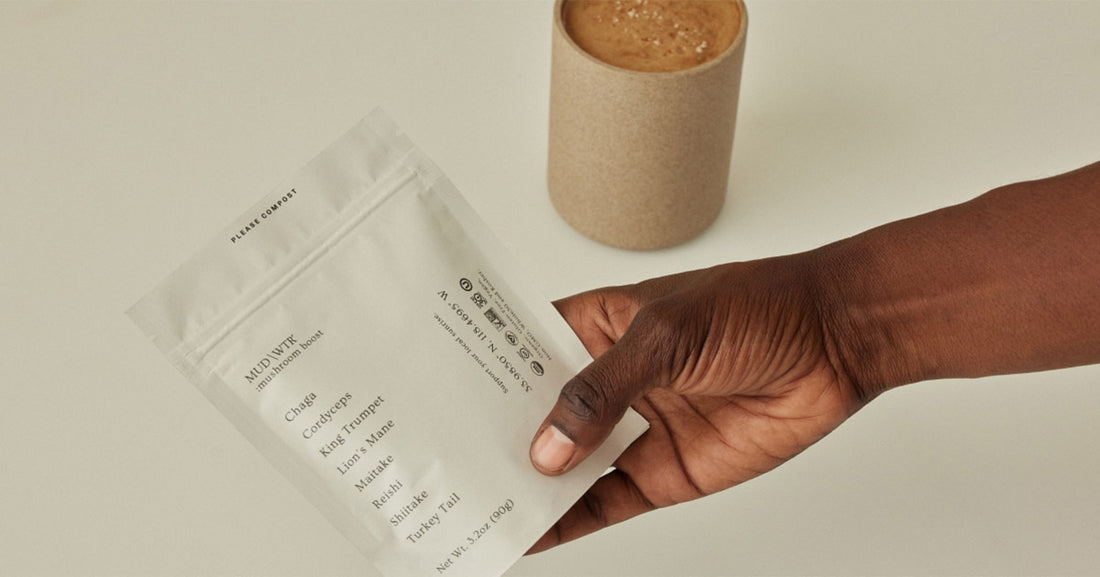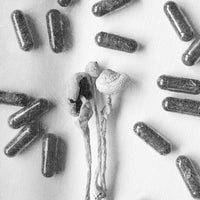Earlier this week, MUD\WTR released :mushroom boost. It's an organic blend of chaga, cordyceps, king trumpet, lion's mane, maitake, reishi, shiitake, turkey tail mushrooms and mycelium cultured on organic oats and/or organic sorghum. We realize it may have you asking yourself questions like, “what does a beta-glucan do?” and “what the hell is mycelium and why does it matter?” If so, we’ve got you.
We sat down with Matt Held, MUD\WTR’s R&D manager, to talk about these fungal quandaries and more.
Hey Matt, so what do you do at MUD\WTR?
I work on new products and the integrity of existing products. I also try to keep us off the FDA's naughty list by making sure everything is buttoned up from a quality standpoint. It’s important to make sure our products stay alive, but it's just as important to make sure they’re not a lie.
You've held similar positions at other companies in the past. Is there anything unique about developing products for MUD\WTR?
Some companies will just sprinkle a little mushroom pixie dust from a random supplier into their product so they can slap it on the label … [whereas] the amount of mushrooms and mycelium we have in mud is significant. You're getting a good amount.
When it comes to what people should know about :mushroom boost, what’s top of mind for you?
How much they can support our immunity due to beta-glucans and other fungal compounds.
Also, the quality of our facilities is worth noting. We work with M2 Ingredients in Carlsbad, Calif., one of the best growers in the country. This is a huge benefit when it comes to traceability and quality. The more you ship things around and put them in different facilities to get processed, the more you open [them] up to adulteration or contamination, especially when going to other countries that may have different standards than the FDA in the USA.
How do mushrooms grow?
First, let’s start in the wild: Mushrooms start as spores. Spores grow into hyphae, which connect into a massive root-like structure called mycelium—the largest and longest living part of the mushroom. It’s responsible for nutrient uptake, the organism’s defense system, all kinds of stuff, and even recently we’ve learned they have an electrical language that they use to communicate. Literal words.
Wacky.
When mycelium detects ideal conditions for reproduction, it will grow fruiting bodies at the surface of whatever it’s growing on, which mature and produce spores. In an uninterrupted environment, those spores would distribute naturally and proliferate. The little mushrooms you see when you’re deluding yourself that you’re out walking in nature in the outskirts of LA are small—they are the temporary reproductive structures, while the bulk of the organism lies beneath your feet. Or in that fallen log, or in that venti half calf 42g sugar caramel macchiato that’s spilled on the side of the path. “Nature.”
How about our mushrooms, which are grown at M2?
At M2, our mushrooms are inoculated on oats, which are sourced from Canada. It’s a clean, organic substrate that’s gluten-free.
They inoculate the oats with a live culture of a particular fungus species. Give them time and the right temperature, both of which have been extensively studied by M2, to produce the ideal shroom. The spore will proliferate into this amazing network of mycelium that will digest the substrate. When the mycelium has grown and is getting ready to reproduce, most species will sprout little fruiting bodies—that's a mushroom. The fruiting bodies grow and at the end of the growth cycle, the oats have been digested and you have this massive, intertwined brick of mycelium and fruiting bodies.
That big brick is then steam treated to help break down the structures and make available the bioactive goodies. They're air dried then ground down into a very fine powder. Finally, they deliver it to us so we can mix it together.
:mushroom boost is made with both the fruiting bodies and the mycelial biomass. What does that mean?
If you’ve ever scraped the surface of most mushroom products, you’ll notice that any company using fruiting body-only extracts will tell you that they are the only beneficial type of mushroom, and will take any and every opportunity to try to smear mycelium products. These are the Karen companies of mushrooms, always screaming that they are right and they want to see your manager.
I’m joking, of course. And to be fair there are also some companies that use mycelium in their products, but don’t allow enough time for the mushroom to digest its substrate. This is where mycelium gets a bad wrap. The key is time. At M2 they’re careful to allow the mycelium enough time to digest its substrate. Plus, mycelium contains a bunch of bioactive compounds that big names in the mushroom industry use in their products as well.
Final question, Matt. If you were a mushroom, which mushroom would you be?
Hmmm, I don't feel holy enough to be reishi. I think I could be a good lion's mane; I have long hair and a lot of my work is mental. You would definitely be cordyceps. You have a ton of positive energy and your hair looks like a long-lost ancestor of cordyceps fruiting bodies.
Read more: Meet :mushroom boost
Read more: How Do Mushrooms Communicate?
Read more: William Padilla-Brown Wants to Empower the World Through Science




